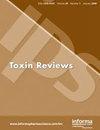Preparation of AC/KOH and AC/Fe3O4/ZnO nanocomposite from waste rice straw for the removal of cyclophosphamide from aqueous solutions
IF 2.4
4区 医学
Q2 TOXICOLOGY
引用次数: 7
Abstract
Abstract In this study, rice straw was used for synthesizing AC/KOH and AC/Fe3O4/ZnO as fresh adsorbents for the elimination of Cyclophosphamide (CP) from water samples. In so doing, the crystalline form, the chemical compound and the morphology of the adsorbents were characterized utilizing scanning electron microscopy (SEM), X-ray diffraction (XRD) spectrometry, Fourier transform infrared spectroscopy (FTIR), vibrating sample magnetometry (VSM), pHpzc, and Brunauer, Emmett, and Teller (BET) methods. Then, the optimum conditions for removal efficiency of CP onto AC/Fe3O4/ZnO nanocomposite were obtained at CP concentration of 20 mg L−1, AC/Fe3O4/ZnO nanocomposite dose of 0.01 g, solution pH of 7, equilibrium time of 45 min, and temperature of 25 °C. The CP adsorption data was modeled by isotherm models (Langmuir, Freundlich, and Temkin) and kinetic models (pseudo-first-order, pseudo-second-order, and intraparticle diffusion) using the origin nonlinear software version 6.1. Based on the results obtained, the maximum adsorption capacities of CP on AC/KOH and AC/Fe3O4/ZnO were 185.6 and 224.3 mg g−1, respectively. In addition, the results of the desorption tests showed that AC/KOH and AC/Fe3O4/ZnO were comfortably regenerated using methanol and sodium hydroxide.废稻草制备AC/KOH和AC/Fe3O4/ZnO纳米复合材料去除水溶液中环磷酰胺
摘要本研究以稻秆为原料合成AC/KOH和AC/Fe3O4/ZnO作为去除水样中环磷酰胺(CP)的新鲜吸附剂。利用扫描电镜(SEM)、x射线衍射(XRD)光谱法、傅里叶变换红外光谱(FTIR)、振动样品磁强计(VSM)、pHpzc和Brunauer, Emmett, and Teller (BET)方法对吸附剂的晶体形态、化合物和形貌进行了表征。在CP浓度为20 mg L−1、AC/Fe3O4/ZnO纳米复合材料用量为0.01 g、溶液pH为7、平衡时间为45 min、温度为25℃的条件下,获得了AC/Fe3O4/ZnO纳米复合材料去除CP的最佳条件。CP吸附数据采用等温模型(Langmuir, Freundlich和Temkin)和动力学模型(伪一阶,伪二阶和颗粒内扩散),使用原点非线性软件6.1。结果表明,CP对AC/KOH和AC/Fe3O4/ZnO的最大吸附量分别为185.6和224.3 mg g−1。此外,解吸实验结果表明,甲醇和氢氧化钠可以很好地再生AC/KOH和AC/Fe3O4/ZnO。
本文章由计算机程序翻译,如有差异,请以英文原文为准。
求助全文
约1分钟内获得全文
求助全文
来源期刊

Toxin Reviews
医学-毒理学
CiteScore
6.80
自引率
0.00%
发文量
36
审稿时长
>12 weeks
期刊介绍:
Toxin Reviews provides an international forum for publishing state-of-the-art reviews and guest-edited single topic special issues covering the multidisciplinary research in the area of toxins derived from animals, plants and microorganisms. Our aim is to publish reviews that are of broad interest and importance to the toxinology as well as other life science communities. Toxin Reviews aims to encourage scientists to highlight the contribution of toxins as research tools in deciphering molecular and cellular mechanisms, and as prototypes of therapeutic agents. Reviews should emphasize the role of toxins in enhancing our fundamental understanding of life sciences, protein chemistry, structural biology, pharmacology, clinical toxinology and evolution. Prominence will be given to reviews that propose new ideas or approaches and further the knowledge of toxinology.
 求助内容:
求助内容: 应助结果提醒方式:
应助结果提醒方式:


